Sarah Sundin's Blog, page 66
January 25, 2024
Today in World War II History—January 25, 1944

Soviet tank assault force on a T-26 light tank in the Korsun area, 1944 (Russian International News Agency image #606710/I. Ozerskij/CC-BY-SA 3.0)
80 Years Ago—Jan. 25, 1944: Soviets surround 60,000 German troops in Korsun-Cherkassy pocket in Ukraine.
US II Corps successfully crosses the Rapido River north of Cassino in Italy.

The Cassino area of Italy, WWII (US Army Center of Military History)
The post Today in World War II History—January 25, 1944 first appeared on Sarah Sundin.January 24, 2024
Today in World War II History—January 24, 1944

Anzio town, looking south toward Nettuno (US Army Center of Military History)
80 Years Ago—Jan. 24, 1944: German bombers sink British hospital ship St. David off Anzio with Hs-293 guided missile; 96 killed, including 2 British nurses.
The US 93rd Evacuation Hospital opens in Anzio and is hit by German shells, injuring a sergeant, the first of many casualties in the Anzio hospitals.
The post Today in World War II History—January 24, 1944 first appeared on Sarah Sundin.January 23, 2024
Today in World War II History—January 23, 1944
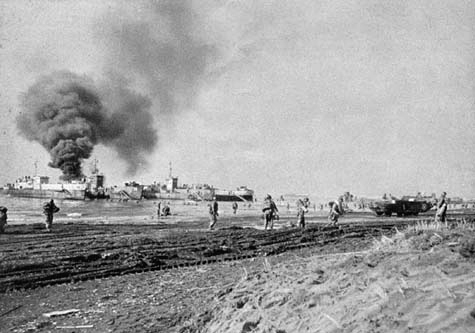
US Army troops land at Anzio, Italy, while ships are bombed by the Luftwaffe, January 1944 (US Army photo)
80 Years Ago—Jan. 23, 1944: Australians take Shaggy Ridge in the Finisterre Mountains of New Guinea, securing the Huon Peninsula.
Countdown to D-day: Gen. Dwight Eisenhower approves a 5-division front for D-day rather than the original 3-division front, which necessitates postponing the invasion date from May 1 to June 1 to obtain enough LSTs (landing ship, tank).
Off Anzio, Luftwaffe bombers sink British destroyer HMS Janus with a glide bomb and damage destroyer HMS Jervis with a Fritz-X bomb.
Norwegian artist Edvard Munch (“The Scream”) dies in Oslo, age 80; his art is banned by the Nazi occupiers.
The post Today in World War II History—January 23, 1944 first appeared on Sarah Sundin.January 22, 2024
Courage Under Fire – US Hospitals at Anzio

Courage under fire.
When we hear that phrase, we picture a soldier in the trenches, a sailor manning his guns, or a pilot dodging enemy fighter planes. But how about nurses and physicians?
In one of my novels, On Distant Shores, the hero serves as a pharmacist in the US 93rd Evacuation Hospital in World War II. On January 23, 1944, the 93rd Evac landed at Anzio, Italy, one day after American and British forces had landed. The armies succeeded in surprising the Germans and faced very little opposition. Due to overcautious leadership and insufficient reinforcements, the forces waited and consolidated the beachhead before driving inland. That proved to be a deadly delay.
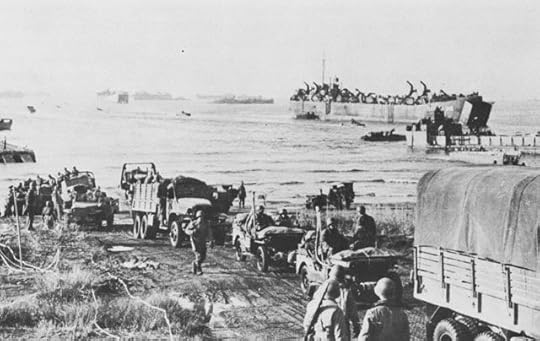
LSTs landing US troops at Anzio, 22 January 1944 (US Army Center of Military History)
While the Allies waited, the Germans shored up their defenses. For the next four months, the Allies would remain trapped on a narrow beachhead, and over 4000 American and British soldiers would die.
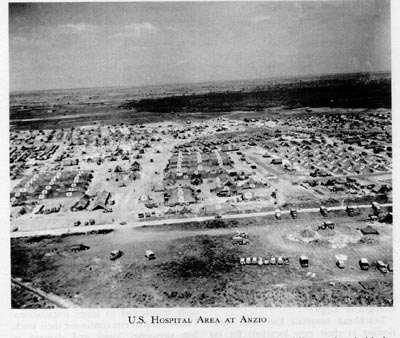
US Hospital Area at Nettuno, near Anzio, Italy, 1944 (US Army Medical Department)
To care for the 11,000 wounded—and the sick—four US Army hospitals served on the beachhead at Nettuno, just south of Anzio, close to the ocean. Although evacuation hospitals were usually set up out of artillery range, the front lines at Anzio were less than ten miles from shore (Read more: Hospitalization in World War II – Chain of Evacuation and Hospitalization in World War II – Mobile and Fixed Hospitals). The khaki hospital tents were marked by enormous red crosses on a white circle, but artillery fire did land on the hospital site—both accidental and deliberate fire.
The Luftwaffe battered these hospitals too in multiple air raids. On February 7, 1944, a German fighter pilot, fleeing from US fighters, jettisoned his bombs for greater maneuverability—while over the 95th Evacuation Hospital. Twenty-eight patients and hospital personnel were killed. Ironically, later that day the pilot was treated at the same hospital after he was shot down.
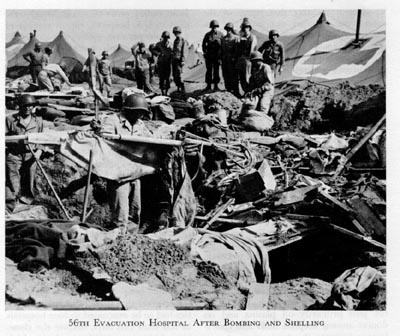
US 56th Evacuation Hospital after an air raid at Nettuno, 1944 (US Army Medical Department)
During the four-month period, dozens of patients, physicians, and medics were killed—and six nurses. When the US Fifth Army made noise about evacuating the nurses, the women made even more noise. They insisted on staying with their patients, and the Army relented.
So they endured. They learned the “Anzio Shuffle,” a duck-walk to stay low and avoid shells. They leaped into slit trenches half full of water during air raids. They lived, and often slept, in their helmets. And they cared for their patients, performing surgery while bombs fell. Several were killed while shielding patients.
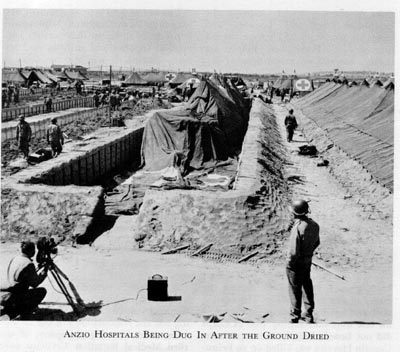
US hospital digging in at Anzio, spring 1944 (US Army Medical Department)
The water table was too high to dig in the hospitals, but as spring dried out the ground, the hospitals dug down. Conditions were so dangerous that some patients deserted the hospitals for the relative safety of the front line, where at least the soldier could shoot back.
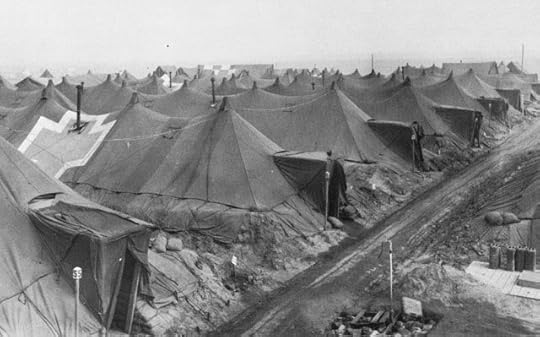
US evacuation hospital tents on the Anzio beachhead, Italy, spring 1944, revetted for protection from bombs and shells (US Army Medical Dept.)
In July 2011, I was able to visit Anzio. The beaches are now covered with resort hotels, Italian families on holiday, and cobalt blue beach chairs. Little remains to commemorate the Battle of Anzio—a single room crammed with artifacts in a local museum and the American cemetery.
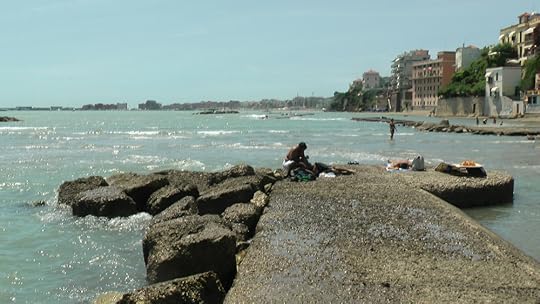
Beach at Nettuno, Italy, looking north to Anzio, July 2011 (Photo: Sarah Sundin)
But I remember. I am inspired by these men and women who endured, who sacrificed, and who cared. They truly demonstrated courage—and grace—under fire.

Sicily-Rome American Cemetery, Nettuno, Italy, July 2011 (Photo: Sarah Sundin)
The post Courage Under Fire – US Hospitals at Anzio first appeared on Sarah Sundin.Today in World War II History—January 22, 1944

US DUKWs landing troops at Anzio, Italy, 22 January 1944 (US National Archives)
80 Years Ago—Jan. 22, 1944: US and British troops land at Anzio, Italy, establish a solid beachhead, and secure the towns of Anzio and Nettuno.
US War Refugee Board is established to resettle European Jews in the US.
The post Today in World War II History—January 22, 1944 first appeared on Sarah Sundin.January 21, 2024
Today in World War II History—January 21, 1944

Air Marshal Sir Roderick Hill is shown the wreckage of a German Junkers Ju 188 bomber shot down by the RAF over Essex on the night of 21 March 1944 during the Little Blitz (Imperial War Museum CH 12537)
80 Years Ago—Jan. 21, 1944: The “Little Blitz” begins (Operation Steinbock), a renewed German air offensive on England: 447 German bombers attack London at night, the largest air raid since July 1942.
In Italy, Allied ships bombard Civitavecchia to deceive Germans about the next day’s landings at Anzio.
The post Today in World War II History—January 21, 1944 first appeared on Sarah Sundin.January 20, 2024
Today in World War II History—January 20, 1944

US casualties being brought back from the Rapido in Italy, January 1944. (US Army Center of Military History)
80 Years Ago—Jan. 20, 1944: US Fifth Army makes first attempt to cross the Rapido River in Italy with heavy casualties, forms a small bridgehead north of Sant’ Angelo.
The post Today in World War II History—January 20, 1944 first appeared on Sarah Sundin.January 19, 2024
Today in World War II History—January 19, 1944

US poster, WWII
80 Years Ago—Jan. 19, 1944: ANZAC Conference begins in Canberra, Australia: Australia and New Zealand discuss postwar relations with US and UK.
British X Corps makes 14 failed attempts to cross the upper Garigliano River in Italy, thus failing to protect US Fifth Army’s left flank for Rapido crossings the next day.
US government returns railways to control of owners after wage dispute is settled.
The post Today in World War II History—January 19, 1944 first appeared on Sarah Sundin.January 18, 2024
Today in World War II History—January 18, 1944

Poster for US Fourth War Loan Drive, 1/18/44-2/15/44
80 Years Ago—Jan. 18, 1944: US Fourth War Loan Drive begins, runs through February 15; sales made in pharmacies are designated for C-47 ambulance planes. Read more: “World War II War Bonds.”
US Navy PBY Catalinas based in Morocco carrying Magnetic Anomaly Detection (MAD) gear begin barrier patrols across the Straits of Gibraltar to detect U-boats transiting submerged at night.
Metropolitan Opera House in New York City holds its first jazz concert, featuring Louis Armstrong, Benny Goodman, Lionel Hampton, Artie Shaw, Roy Eldridge, and Jack Teagarden.
The post Today in World War II History—January 18, 1944 first appeared on Sarah Sundin.January 17, 2024
Today in World War II History—January 17, 1944

British X Corps shuttling ambulances across the Garigliano River, January 1944 (US Army Center for Military History)
80 Years Ago—Jan. 17, 1944: British X Corps crosses lower Garigliano River in Italy, officially beginning the Battle of Cassino.
US Army and Marines secure Arawe area on New Britain in the Solomons.
The post Today in World War II History—January 17, 1944 first appeared on Sarah Sundin.


